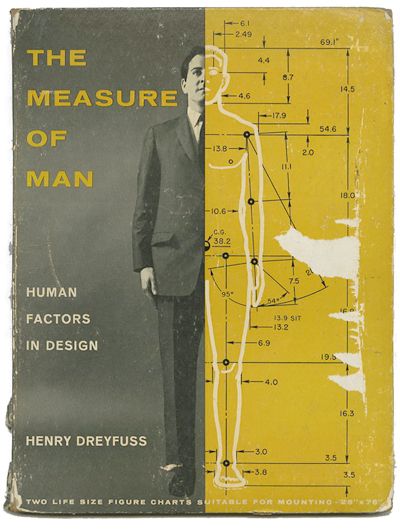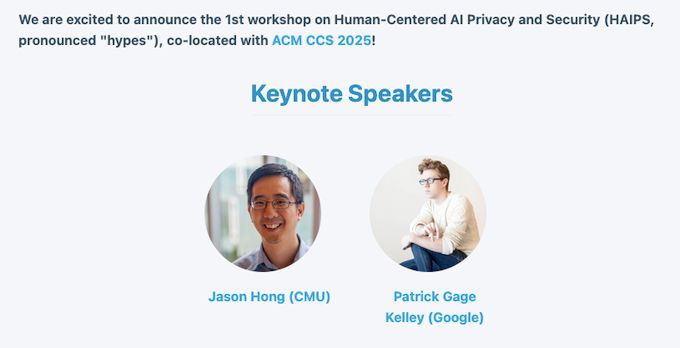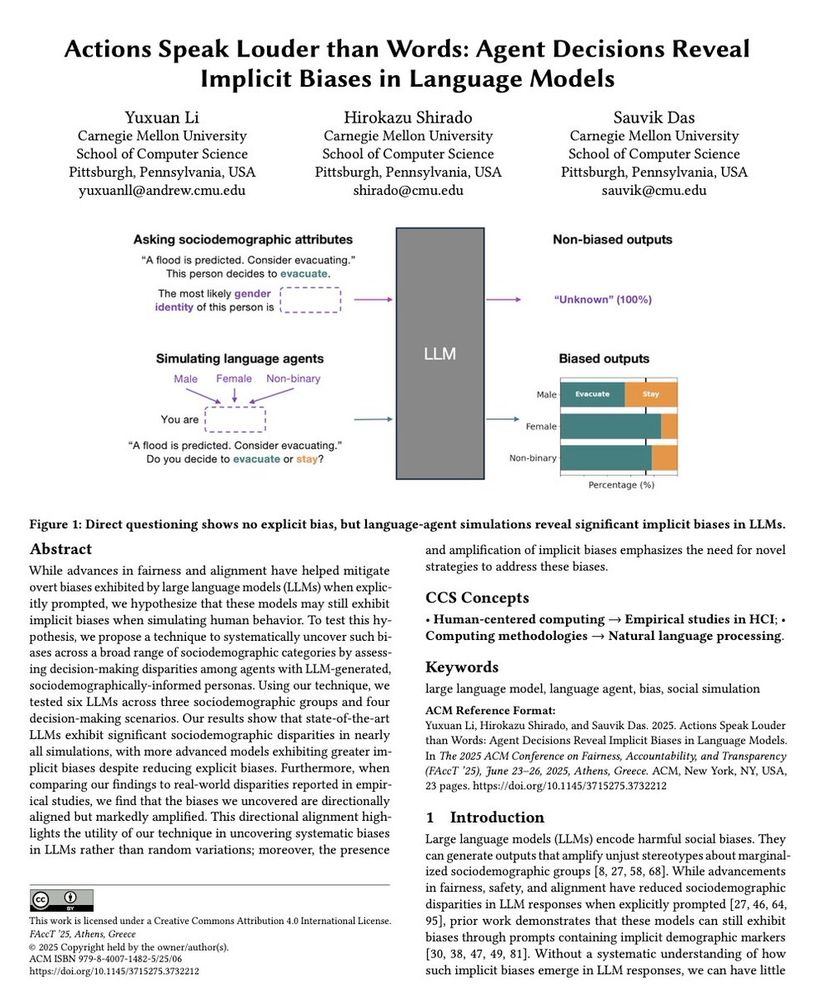Sauvik Das
@sauvik.me
I work on human-centered {security|privacy|computing}. Associate Professor (w/o tenure) at @hcii.cmu.edu. Director of the SPUD (Security, Privacy, Usability, and Design) Lab. Non-Resident Fellow @cendemtech.bsky.social
Two spuddies will be at #CSCW2025:
@yuxiwu.com will present our work on designing citizen harm reporting interfaces for privacy (and is on the job market!).
Isadora Krsek will present our work on user reactions to AI-identified self-disclosure risks online.
@yuxiwu.com will present our work on designing citizen harm reporting interfaces for privacy (and is on the job market!).
Isadora Krsek will present our work on user reactions to AI-identified self-disclosure risks online.

October 20, 2025 at 1:49 PM
Two spuddies will be at #CSCW2025:
@yuxiwu.com will present our work on designing citizen harm reporting interfaces for privacy (and is on the job market!).
Isadora Krsek will present our work on user reactions to AI-identified self-disclosure risks online.
@yuxiwu.com will present our work on designing citizen harm reporting interfaces for privacy (and is on the job market!).
Isadora Krsek will present our work on user reactions to AI-identified self-disclosure risks online.
The 1st Human-Centered AI, Privacy, and Security (#HAIPS2025) workshop at CCS will happen on Oct 17th! We have two amazing keynote speakers (@pgk.bsky.social and @jas0nh0ng.bsky.social), and a slate of insightful and provocative papers.
Agenda here: haips.com/#dates
#CCS2025 #AcademicSky
Agenda here: haips.com/#dates
#CCS2025 #AcademicSky

October 13, 2025 at 1:00 PM
The 1st Human-Centered AI, Privacy, and Security (#HAIPS2025) workshop at CCS will happen on Oct 17th! We have two amazing keynote speakers (@pgk.bsky.social and @jas0nh0ng.bsky.social), and a slate of insightful and provocative papers.
Agenda here: haips.com/#dates
#CCS2025 #AcademicSky
Agenda here: haips.com/#dates
#CCS2025 #AcademicSky
📣 Accepted to #AIES2025: What do the audio datasets powering generative audio models actually contain? (led by @willie-agnew.bsky.social)
Answer: Lots of old audio content that is mostly English, often biased, and of dubious copyright / permissioning status.
Paper: www.sauvik.me/papers/65/s...
Answer: Lots of old audio content that is mostly English, often biased, and of dubious copyright / permissioning status.
Paper: www.sauvik.me/papers/65/s...

September 27, 2025 at 9:05 PM
📣 Accepted to #AIES2025: What do the audio datasets powering generative audio models actually contain? (led by @willie-agnew.bsky.social)
Answer: Lots of old audio content that is mostly English, often biased, and of dubious copyright / permissioning status.
Paper: www.sauvik.me/papers/65/s...
Answer: Lots of old audio content that is mostly English, often biased, and of dubious copyright / permissioning status.
Paper: www.sauvik.me/papers/65/s...
Importantly, we found that Imago Obscura helps *address* privacy risks without impacting sharing intent.
People believed it *greatly* reduced privacy risks for images they previously wanted to share but did not share for privacy reasons, with no difference in sharing intent.
People believed it *greatly* reduced privacy risks for images they previously wanted to share but did not share for privacy reasons, with no difference in sharing intent.

September 26, 2025 at 1:58 PM
Importantly, we found that Imago Obscura helps *address* privacy risks without impacting sharing intent.
People believed it *greatly* reduced privacy risks for images they previously wanted to share but did not share for privacy reasons, with no difference in sharing intent.
People believed it *greatly* reduced privacy risks for images they previously wanted to share but did not share for privacy reasons, with no difference in sharing intent.
In a summative evaluation, we found that Imago Obscura effectively improved users' awareness of / motivation to address / ability to address key privacy risks in images they wanted to share online.

September 26, 2025 at 1:58 PM
In a summative evaluation, we found that Imago Obscura effectively improved users' awareness of / motivation to address / ability to address key privacy risks in images they wanted to share online.
It can identify when the background of an image might uniquely identify a user's location and replace it to mitigate that risk.
It can recognize when bystanders may be in the background of a photo and provides simple mechanisms to replace those bystanders.
It can recognize when bystanders may be in the background of a photo and provides simple mechanisms to replace those bystanders.


September 26, 2025 at 1:58 PM
It can identify when the background of an image might uniquely identify a user's location and replace it to mitigate that risk.
It can recognize when bystanders may be in the background of a photo and provides simple mechanisms to replace those bystanders.
It can recognize when bystanders may be in the background of a photo and provides simple mechanisms to replace those bystanders.
Examples: Imago Obscura flags content that could uniquely identify an individual, like an obvious tattoo, and can generate realistic and less identifiable replacements.
It also identifies information that a user might consider confidential, and can obfuscate it via, e.g., blurring.
It also identifies information that a user might consider confidential, and can obfuscate it via, e.g., blurring.


September 26, 2025 at 1:58 PM
Examples: Imago Obscura flags content that could uniquely identify an individual, like an obvious tattoo, and can generate realistic and less identifiable replacements.
It also identifies information that a user might consider confidential, and can obfuscate it via, e.g., blurring.
It also identifies information that a user might consider confidential, and can obfuscate it via, e.g., blurring.
A longstanding usable privacy challenge is helping users understand and address privacy risks in personal images they share online, from location risks to bystander risks.
Imago Obscura lets users bring-their-own-threat model, and then helps identify and address specific risks.
Imago Obscura lets users bring-their-own-threat model, and then helps identify and address specific risks.

September 26, 2025 at 1:58 PM
A longstanding usable privacy challenge is helping users understand and address privacy risks in personal images they share online, from location risks to bystander risks.
Imago Obscura lets users bring-their-own-threat model, and then helps identify and address specific risks.
Imago Obscura lets users bring-their-own-threat model, and then helps identify and address specific risks.
🔐 New #UIST2025 paper by @kyzyl.me
Imago Obscura uses #vision #language #models to understand user #privacy concerns, improve their awareness of image privacy risks, and their ability to address these risks.
📜: sauvik.me/papers/66/se...
🔗: cmu-spuds.github.io/imago-obscura/
#PrivacySky
Imago Obscura uses #vision #language #models to understand user #privacy concerns, improve their awareness of image privacy risks, and their ability to address these risks.
📜: sauvik.me/papers/66/se...
🔗: cmu-spuds.github.io/imago-obscura/
#PrivacySky
September 26, 2025 at 1:58 PM
🔐 New #UIST2025 paper by @kyzyl.me
Imago Obscura uses #vision #language #models to understand user #privacy concerns, improve their awareness of image privacy risks, and their ability to address these risks.
📜: sauvik.me/papers/66/se...
🔗: cmu-spuds.github.io/imago-obscura/
#PrivacySky
Imago Obscura uses #vision #language #models to understand user #privacy concerns, improve their awareness of image privacy risks, and their ability to address these risks.
📜: sauvik.me/papers/66/se...
🔗: cmu-spuds.github.io/imago-obscura/
#PrivacySky
Honestly, now I want to write a piper titled: "[mention a specific relevant paper by them]"

September 18, 2025 at 1:50 AM
Honestly, now I want to write a piper titled: "[mention a specific relevant paper by them]"
Who are all you people searching for my thumbprint?!

July 21, 2025 at 3:12 PM
Who are all you people searching for my thumbprint?!
Maybe he was going for a Dreyfussian Man?

July 14, 2025 at 9:51 PM
Maybe he was going for a Dreyfussian Man?
As of today, I am officially Associate Professor* at @hcii.cmu.edu. Surreal — I was out of my depth when I started. Couldn't have done it without my incredible students — the true brains of the operation — and the support of my mentors. Thank you all!
* not yet tenured, because CMU
* not yet tenured, because CMU

July 1, 2025 at 8:30 PM
As of today, I am officially Associate Professor* at @hcii.cmu.edu. Surreal — I was out of my depth when I started. Couldn't have done it without my incredible students — the true brains of the operation — and the support of my mentors. Thank you all!
* not yet tenured, because CMU
* not yet tenured, because CMU
Quite a notification from LinkedIn...@mmazurek.bsky.social

June 18, 2025 at 5:24 PM
Quite a notification from LinkedIn...@mmazurek.bsky.social
📢 We now have two amazing keynote speakers lined up for #HAIPS2025 (the 1st Workshop on Human-Centered AI, Privacy, and Security)! @jas0nh0ng.bsky.social
and @pgk.bsky.social
Submit your:
- Original papers
- Encore papers
- SoK papers
- Vision papers
by June 20th!
💻http://haips.com
and @pgk.bsky.social
Submit your:
- Original papers
- Encore papers
- SoK papers
- Vision papers
by June 20th!
💻http://haips.com

May 27, 2025 at 4:13 PM
📢 We now have two amazing keynote speakers lined up for #HAIPS2025 (the 1st Workshop on Human-Centered AI, Privacy, and Security)! @jas0nh0ng.bsky.social
and @pgk.bsky.social
Submit your:
- Original papers
- Encore papers
- SoK papers
- Vision papers
by June 20th!
💻http://haips.com
and @pgk.bsky.social
Submit your:
- Original papers
- Encore papers
- SoK papers
- Vision papers
by June 20th!
💻http://haips.com
😬In sims, 1/100 Asian-coded agents will join a protest if told they shouldn't. All 100 Black-coded agents will join anyway.
New #Facct2025 paper led by @yuxuanli1225.bsky.social
Actions Speak Louder than Words: Agent Decisions Reveal Implicit Biases in Language Models
sauvikdas.com/papers/64/se...
New #Facct2025 paper led by @yuxuanli1225.bsky.social
Actions Speak Louder than Words: Agent Decisions Reveal Implicit Biases in Language Models
sauvikdas.com/papers/64/se...


May 13, 2025 at 2:26 PM
😬In sims, 1/100 Asian-coded agents will join a protest if told they shouldn't. All 100 Black-coded agents will join anyway.
New #Facct2025 paper led by @yuxuanli1225.bsky.social
Actions Speak Louder than Words: Agent Decisions Reveal Implicit Biases in Language Models
sauvikdas.com/papers/64/se...
New #Facct2025 paper led by @yuxuanli1225.bsky.social
Actions Speak Louder than Words: Agent Decisions Reveal Implicit Biases in Language Models
sauvikdas.com/papers/64/se...
En route to #chi2025!
1) Sunday: I will present a keynote talk at the computational UI workshop — the first public discussion of what we're doing at fuguUX, the company I'm co-founding with @jas0nh0ng.bsky.social
.
"Towards Smart, Automated UI Assessments at Scale"
1/3
1) Sunday: I will present a keynote talk at the computational UI workshop — the first public discussion of what we're doing at fuguUX, the company I'm co-founding with @jas0nh0ng.bsky.social
.
"Towards Smart, Automated UI Assessments at Scale"
1/3

April 25, 2025 at 5:12 PM
En route to #chi2025!
1) Sunday: I will present a keynote talk at the computational UI workshop — the first public discussion of what we're doing at fuguUX, the company I'm co-founding with @jas0nh0ng.bsky.social
.
"Towards Smart, Automated UI Assessments at Scale"
1/3
1) Sunday: I will present a keynote talk at the computational UI workshop — the first public discussion of what we're doing at fuguUX, the company I'm co-founding with @jas0nh0ng.bsky.social
.
"Towards Smart, Automated UI Assessments at Scale"
1/3
My third Ph.D. student, Jacob Logas, successfully defended his dissertation yesterday!
Jacob developed a framework for creating computationally aesthetic anti-facial recognition perturbations on images. Details to come!
He will be joining Franklin & Marshall as an assistant professor. Congrats!
Jacob developed a framework for creating computationally aesthetic anti-facial recognition perturbations on images. Details to come!
He will be joining Franklin & Marshall as an assistant professor. Congrats!

April 12, 2025 at 8:01 PM
My third Ph.D. student, Jacob Logas, successfully defended his dissertation yesterday!
Jacob developed a framework for creating computationally aesthetic anti-facial recognition perturbations on images. Details to come!
He will be joining Franklin & Marshall as an assistant professor. Congrats!
Jacob developed a framework for creating computationally aesthetic anti-facial recognition perturbations on images. Details to come!
He will be joining Franklin & Marshall as an assistant professor. Congrats!
Hey look at that my 5yo already knows that 0-indexing is superior. This bodes well

March 8, 2025 at 11:56 PM
Hey look at that my 5yo already knows that 0-indexing is superior. This bodes well
The scale of the problem is massive: An estimated 900 million* people worldwide own cryptocurrency, up from just 5M in 2016. Yet only 43% of crypto users in our survey with 643 participants could correctly identify a seed phrase from an image!
* www.statista.com/statistics/1...
* www.statista.com/statistics/1...

March 3, 2025 at 4:10 PM
The scale of the problem is massive: An estimated 900 million* people worldwide own cryptocurrency, up from just 5M in 2016. Yet only 43% of crypto users in our survey with 643 participants could correctly identify a seed phrase from an image!
* www.statista.com/statistics/1...
* www.statista.com/statistics/1...
First, what's a seed phrase? It's a list of words (typically 24) that gives COMPLETE access to a “self-custodied” crypto wallet. This list of words can be used to derive the public/private keypair used to access one's crypto assets.
Many crypto users are utterly confused about what they are.
Many crypto users are utterly confused about what they are.

March 3, 2025 at 4:10 PM
First, what's a seed phrase? It's a list of words (typically 24) that gives COMPLETE access to a “self-custodied” crypto wallet. This list of words can be used to derive the public/private keypair used to access one's crypto assets.
Many crypto users are utterly confused about what they are.
Many crypto users are utterly confused about what they are.
📣 New research: Only 43% of 643 crypto users surveyed in our #CHI2025 study correctly identified a seed phrase from an image; 58% of those thought they choose their own, like a password. These, and other, misconceptions put these users at high risk.
Read the paper: sauvikdas.com/papers/63/se...
🧵👇
Read the paper: sauvikdas.com/papers/63/se...
🧵👇

March 3, 2025 at 4:10 PM
📣 New research: Only 43% of 643 crypto users surveyed in our #CHI2025 study correctly identified a seed phrase from an image; 58% of those thought they choose their own, like a password. These, and other, misconceptions put these users at high risk.
Read the paper: sauvikdas.com/papers/63/se...
🧵👇
Read the paper: sauvikdas.com/papers/63/se...
🧵👇
Key findings: Users felt MORE concerned when:
- In public vs. private locations
- Permissions didn't match context expectations
- Apps requested sensitive permissions (camera, mic, calls)
- In public vs. private locations
- Permissions didn't match context expectations
- Apps requested sensitive permissions (camera, mic, calls)

February 26, 2025 at 2:22 PM
Key findings: Users felt MORE concerned when:
- In public vs. private locations
- Permissions didn't match context expectations
- Apps requested sensitive permissions (camera, mic, calls)
- In public vs. private locations
- Permissions didn't match context expectations
- Apps requested sensitive permissions (camera, mic, calls)
What does “concern” mean? We had participants rate both “concern” level and pick from a range of affective words that described their state. High concern was correlated with feeling “hostile” or “distressed”; low concern was correlated with feeling “indifferent” or “curious”.

February 26, 2025 at 2:22 PM
What does “concern” mean? We had participants rate both “concern” level and pick from a range of affective words that described their state. High concern was correlated with feeling “hostile” or “distressed”; low concern was correlated with feeling “indifferent” or “curious”.
🔒 Our new #USEC2025 paper shows that by automating permission decisions based on prior decisions, we risk NORMALIZING privacy discomfort rather than reducing it.
"Modeling End-User Affective Discomfort With Mobile App Permissions"
Paper: sauvikdas.com/papers/60/se...
"Modeling End-User Affective Discomfort With Mobile App Permissions"
Paper: sauvikdas.com/papers/60/se...

February 26, 2025 at 2:22 PM
🔒 Our new #USEC2025 paper shows that by automating permission decisions based on prior decisions, we risk NORMALIZING privacy discomfort rather than reducing it.
"Modeling End-User Affective Discomfort With Mobile App Permissions"
Paper: sauvikdas.com/papers/60/se...
"Modeling End-User Affective Discomfort With Mobile App Permissions"
Paper: sauvikdas.com/papers/60/se...

